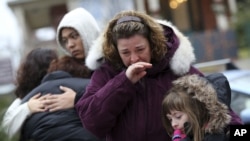Near simultaneous attacks on elementary schools in both the United States and China have prompted many to examine the very different approach each nation takes on gun control laws.
Armed with a rifle and two handguns, 20-year-old Adam Lanza was able to carry out one of the worst mass shootings in U.S. history on Friday, killing 20 children and six adults at the Sandy Hook Elementary School in Newtown, Connecticut.
Henan attack
Just hours earlier, a disturbed 36-year-old Chinese man, armed with a kitchen knife, walked into an elementary school in central Henan province and allegedly began attacking students. Although police say he was able to injure 23 children and an elderly villager, none of the injuries were severe and he was subdued a short time later by police and teachers.
It was the latest in a series of violent attacks on students in China that has led to soul-searching and increased security outside educational institutions. But nearly all of the incidents involved less deadly weapons such as knives, meat cleavers, or hammers, and there has been nothing that approaches the scale of Friday's tragedy in the U.S.
Joseph Cheng, a professor at City University in Hong Kong, says that he attributes this to China's tough gun laws, which make it nearly impossible for regular citizens to obtain firearms.
"Basically, unless you are a well-organized criminal gang, you normally do not have access to guns and modern weapons," says Cheng. "And ,since these cases are related to mentally disturbed people, they normally grab choppers and hammers from the kitchen in their homes and use these as weapons."
Homicide rate comparison
The United Nations estimates that China's overall homicide rate is less than a quarter of that of the United States. Gun control advocates argue this is because China, which has over a billion more people than the U.S., has only a fraction of the number of the U.S.' guns.
"Certainly China has a much better control of weapons in comparison with the United States," said Cheng, who admits that guns are available for those who want them. "Because of the corruption of the military, there is apparently a pretty large circulation of small weapons in the black market."
But, Cheng says even if you are able to pay what it takes to illegally obtain guns, many are deterred from doing so because of the heavy penalties associated with illegal gun ownership.
Those found in possession of a single gun can get a prison sentence for as long as three years and many receive the death penalty for committing gun crimes in China, which regularly leads the world in annual executions.
Gun laws
Michael DeGolyer, who teaches government and international studies at the Hong Kong Baptist University, acknowledges that China's restrictive gun laws "possibly" play a part in reducing violence.
But he says he is concerned that, school children in countries around the world seem to be increasingly the target of violent attacks, no matter what type of weapon being used.
"The use of guns is higher in the United States in these kinds of attacks. But I think the fact that we have had attacks on schools, on children, not just in the United States, but in China and in other places - Norway, Pakistan - may indicate that we are getting a more widespread kind of stressor," he says.
Mental illness factor
In China, many have blamed the attacks on weaknesses in the Chinese medical system's ability to diagnose and treat psychiatric illnesses, which have been on the rise as many are unable to cope with the rapid pace of social change.
But DeGolyer is reluctant to blame just one factor.
"I think this is an area that definitely calls for research instead of pointing fingers or trying to argue that this is one particular cause or another," says DeGolyer. "Of course, the control of weaponry is one of the actions you can take to try to address the extent of the violence, but why are we seeing rising attacks on children globally? What is behind that?"
Armed with a rifle and two handguns, 20-year-old Adam Lanza was able to carry out one of the worst mass shootings in U.S. history on Friday, killing 20 children and six adults at the Sandy Hook Elementary School in Newtown, Connecticut.
Henan attack
Just hours earlier, a disturbed 36-year-old Chinese man, armed with a kitchen knife, walked into an elementary school in central Henan province and allegedly began attacking students. Although police say he was able to injure 23 children and an elderly villager, none of the injuries were severe and he was subdued a short time later by police and teachers.
It was the latest in a series of violent attacks on students in China that has led to soul-searching and increased security outside educational institutions. But nearly all of the incidents involved less deadly weapons such as knives, meat cleavers, or hammers, and there has been nothing that approaches the scale of Friday's tragedy in the U.S.
Joseph Cheng, a professor at City University in Hong Kong, says that he attributes this to China's tough gun laws, which make it nearly impossible for regular citizens to obtain firearms.
"Basically, unless you are a well-organized criminal gang, you normally do not have access to guns and modern weapons," says Cheng. "And ,since these cases are related to mentally disturbed people, they normally grab choppers and hammers from the kitchen in their homes and use these as weapons."
Homicide rate comparison
US Gun Violence Compared to the Rest of the World
A look at how the U.S. ranks in comparison to the rest of world when it comes guns and gun violence.
The U.S. has the highest gun ownership rate in the world.
GUN OWNERSHIP PER 100 PEOPLE
1. United States - 89
2. Yemen - 55
3. Switzerland - 46
4. Finland - 45
5. Serbia - 38
--------------------------------------------
Despite the high number of guns, because of its large population, the U.S. does not have the worst firearms murder rate.
GUN MURDERS PER 100,000 PEOPLE
1. Honduras - 69
2. El Salvador - 40
3. Jamaica - 39
4 Venezuela - 39
5. Guatemala - 35
The United States ranks 28th, with a rate of 3 per 100,000 people
-----------------------------------------
*The U.S. is one of the leading countries in the number of deaths attributed to guns.
NUMBER OF PEOPLE KILLED BY FIREARMS IN 2010
1. Brazil - 34,678
2. Colombia - 12,539
3. Mexico - 11,309
4. Venezuela - 11,115
5. United States - 9,146
Source: UNODC & Small arms survey of 2010
"Certainly China has a much better control of weapons in comparison with the United States," said Cheng, who admits that guns are available for those who want them. "Because of the corruption of the military, there is apparently a pretty large circulation of small weapons in the black market."
But, Cheng says even if you are able to pay what it takes to illegally obtain guns, many are deterred from doing so because of the heavy penalties associated with illegal gun ownership.
Those found in possession of a single gun can get a prison sentence for as long as three years and many receive the death penalty for committing gun crimes in China, which regularly leads the world in annual executions.
Gun laws
Michael DeGolyer, who teaches government and international studies at the Hong Kong Baptist University, acknowledges that China's restrictive gun laws "possibly" play a part in reducing violence.
But he says he is concerned that, school children in countries around the world seem to be increasingly the target of violent attacks, no matter what type of weapon being used.
"The use of guns is higher in the United States in these kinds of attacks. But I think the fact that we have had attacks on schools, on children, not just in the United States, but in China and in other places - Norway, Pakistan - may indicate that we are getting a more widespread kind of stressor," he says.
Mental illness factor
In China, many have blamed the attacks on weaknesses in the Chinese medical system's ability to diagnose and treat psychiatric illnesses, which have been on the rise as many are unable to cope with the rapid pace of social change.
But DeGolyer is reluctant to blame just one factor.
"I think this is an area that definitely calls for research instead of pointing fingers or trying to argue that this is one particular cause or another," says DeGolyer. "Of course, the control of weaponry is one of the actions you can take to try to address the extent of the violence, but why are we seeing rising attacks on children globally? What is behind that?"












